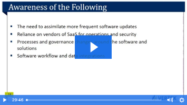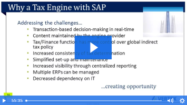SAP Global Tax Management
Filter By
Browse By
- SAP Analytics and AI
- SAP Application Development and Integration
- All SAP Application Development and Integration
- SAP ABAP
- SAP ABAP Development Tools
- SAP ABAP Test Cockpit
- SAP API Management
- SAP BAPI
- SAP Basis
- SAP BRF
- SAP Business Application Studio
- SAP CMS
- SAP Design Studio
- SAP Development Tools
- SAP DevOps
- SAP EAI
- SAP EDI
- SAP Extension Suite
- SAP Fiori
- SAP Fiori Elements
- SAP Integration Suite
- SAP Low Code Application Development
- SAP Low Code Automation
- SAP Netweaver
- SAP Release Management
- SAP UI5
- SAP Web Application Server
- SAP Web IDE
- SAP Business Process Management
- SAP Center of Excellence
- SAP CIO
- SAP Customer Experience
- SAP Data and Data Management
- All SAP Data and Data Management
- SAP BW
- SAP BW/4HANA
- SAP Crystal Reporting
- SAP Data Archiving
- SAP Data Center
- SAP Data Governance
- SAP Data Integration
- SAP Data Migration
- SAP Data Quality
- SAP Data Services
- SAP Data Strategy
- SAP Data Visualization
- SAP Data Warehouse Cloud
- SAP DMS
- SAP Document Control
- SAP EIM
- SAP ETL
- SAP ETL Tools
- SAP HANA
- SAP HANA Administration
- SAP HANA Deployment Infrastructure
- SAP HANA Studio
- SAP Master Data
- SAP Master Data Governance
- SAP MDM
- SAP Enterprise Architect
- SAP Enterprise Asset Management
- SAP ERP
- SAP Finance
- All SAP Finance
- SAP Accounting
- SAP AR AP
- SAP Asset Accounting
- SAP Billing Systems
- SAP BPC
- SAP BRIM
- SAP Cash Management
- SAP Central Finance
- SAP Controlling
- SAP COPA
- SAP Cost Center Accounting
- SAP e-invoicing
- SAP FICO
- SAP Finance Automation
- SAP Financial Closing Cockpit
- SAP Financial Consolidation
- SAP Financial Planning
- SAP FX Risk
- SAP General Ledger
- SAP Global Tax Management
- SAP Hyperion
- SAP Order to Cash
- SAP Payment Processing
- SAP Profitability Analysis
- SAP Rebate Management
- SAP S/4HANA Finance
- SAP Universal Journal
- SAP Governance Risk and Compliance
- SAP Human Capital Management
- SAP Intelligent Technologies
- SAP Platform and Technology
- All SAP Platform and Technology
- SAP Business Technology Platform
- SAP Cloud Connector
- SAP Cloud Integration Platform
- SAP Cloud Migration
- SAP Cloud Platform
- SAP Cloud Providers
- SAP Cloud Strategy
- SAP Container Platform
- SAP Digital Asset Management
- SAP Digital Integration Hub
- SAP Digital Signature
- SAP HANA Enterprise Cloud
- SAP HEC
- SAP Hyperscalers
- SAP Infrastructure
- SAP Messaging
- SAP Smart Forms
- SAP Quality and Testing
- SAP Security
- SAP Spend Management
- SAP Supply Chain Management
- All SAP Supply Chain Management
- SAP APO
- SAP Asset Management
- SAP Business Network
- SAP Digital Manufacturing Cloud
- SAP Digital Twin
- SAP EWM
- SAP IBP
- SAP Inventory Management
- SAP Label Printing
- SAP Logistics
- SAP Manufacturing
- SAP Manufacturing Automation
- SAP MES
- SAP MII
- SAP MM
- SAP MRO
- SAP MRP
- SAP Order Management
- SAP Plant Maintenance
- SAP PLM
- SAP Production Planning
- SAP S&OP
- SAP SD
- SAP SPM
- SAP Supply Chain Planning
- SAP Track and Trace
- SAP Transportation Management
- SAP System Administration
Global Tax Management: An Overview and Key Considerations
What is Global Tax Management
Global tax management is the process by which tax managers evaluate the global taxability of an organization’s industry, corporate structure, business model, operations, products or services, business activities, and daily transactions.
To ensure global tax reporting requirements are met accurately and consistently by all subsidiaries across multiple tax jurisdictions, global tax management requires a holistic view of an organization’s entire flow of transactional data across its entire value chain.
Global tax management brings together disparate technologies from multiple vendors, such as SAP, Vertex, Sovos, Avalara, Thomson Reuters, and different currencies and various regulators, contributing to complexity across the tax function.
Global Tax Management: An Overview and Key Considerations
What is Global Tax Management
Global tax management is the process by which tax managers evaluate the global taxability of an organization’s industry, corporate structure, business model, operations, products or services, business activities, and daily transactions.
To ensure global tax reporting requirements are met accurately and consistently by all subsidiaries across multiple tax jurisdictions, global tax management requires a holistic view of an organization’s entire flow of transactional data across its entire value chain.
Global tax management brings together disparate technologies from multiple vendors, such as SAP, Vertex, Sovos, Avalara, Thomson Reuters, and different currencies and various regulators, contributing to complexity across the tax function.
For many organizations, global tax management typically involves these three steps:
- Define compliance needs worldwide across all operating units, lines of business, tax jurisdictions.
- Map businesss processes to govern how compliance should flow through the organization globally.
- Implement technology solutions that can accurately collect information and content updates from disparate sources in alignment with defined business processes to deliver master data and financial information asynchronously as required.
Key Considerations for SAPinsiders
Understand the growing complexity of global tax management. Organizations considering different areas of the world for new potential opportunities must be aware of how these business interests can affect the local country’s taxation. Changing legislation and mandates around global tax management is becoming ever more complex as organizations face growing challenges in evaluating how their growth initiatives may impact global tax liabilities.
Evaluate your content needs for effective global tax compliance. Tax managers need to consider what global activities may be taxed in which locations and ensure that they are meeting the tax requirements of each country accurately and promptly. Greater global tax compliance efficiency can help organizations reallocate accounting resources to support revenue-generating tax compliance opportunities.
Implement technology to simplify global tax management needs. The Ingram Micro and Dow Chemicals case studies provide best practices outlining how technology makes it possible to create a global view of the enterprise, enabling tax function managers responsible for global compliance, global reporting, and global controls. Content updates that provide real-time data on tax jurisdictions, tax rates, and tax content changes are critical for efficient global tax compliance.
107 results
-

How to Prevent Complexity from Taxing the Customer Experience
Reading time: 6 mins
The adjective “seamless” now goes hand-in-hand with the phrase “customer experience” for a good reason: these capabilities deliver a competitive advantage to most business-to-consumer (B2C) and business-to-business (B2B) companies across all industries, and particularly in the retail industry.
-

Overcome Hidden Tax Compliance Barriers To Your SAP Central Finance Migration
Reading time: 1 min
For some SAP customers planning a move to Central Finance, tax compliance may not be a priority. Unfortunately, that will be a costly oversight. Download this white paper to learn how to prevent these roadblaocks and what a successful migration to SAP Cen This content is for Basic Access, SAPinsider Monthly Subscription, SAPinsider Annual Subscription,…
-

- SAP Global Tax Management
 Premium
Premium
Financials: Case study: How the Dow Chemical Company transformed its SAP global finance operations with centralized tax management
Reading time: 1 mins
Learn how the Dow Chemical Company successfully centralized its tax management processes. FIN2017_OBoyle_Casestudyhowthedow Shari O’Boyle If you have comments about this article or publication, or would like to submit an article idea, please contact the editor…. This content is for SAPinsider Monthly Subscription, SAPinsider Annual Subscription, and SAPinsider Premium Annual Subscription members only.Log In Join...…
-
-

- SAP Global Tax Management
 Premium
Premium
HR: Case study: How the University of Tennessee automated the process of applying support packs and tax update bulletins
Reading time: 1 mins
Learn how the University of Tennessee expedited the testing process for applying support packs and BSI tax update bulletins (TUBs) and/or BSI TaxFactory upgrades to its on-premise environment. HR2017_Musharbash_Casestudyhowtheuniversity Sam Musharbash If you have comments about this article or publication, or would like to submit an article idea, please contact the editor…. This content is...…
-

The Changing Tax Landscape: Can Your Technology Handle It?
Reading time: 30 mins
An exclusive Q&A with Central Finance Bootcamp speaker David Dixon. This content is for Basic Access, SAPinsider Monthly Subscription, SAPinsider Annual Subscription, and SAPinsider Premium Annual Subscription members only.Log In Join Now
-

How to Automate Taxation of Wages Using a Flat-Rate Method During an Adjustment Payroll Run
Reading time: 10 mins
SAP payroll schema and BSI TaxFactory 10.0 are tools that can be used to customize taxation of wages paid to employees. Learn how to customize and automate tax calculations on supplemental wages using a flat-rate method during adjustment payroll using SAP payroll and BSI TaxFactory 10.0. This content is for Basic Access, SAPinsider Monthly Subscription,…
-

How Utilizing a Cloud Tax Engine Can Lead to Increased ROI
Global enterprises continue to expand their cloud strategy, focusing efforts on specific back office business functions which can benefit from the elasticity, scalability, and faster ROI from cloud technologies. This session from Vertex’s Mark Sieczkowski and Brian Wilchusky offers insight into why a cloud/SaaS solution is a recommended approach for complex tax compliance issues such…...…
-
-

Is Your Tax Technology Future Ready?
Reading time: 3 mins
Having the right tax technology in place is crucial for dealing with the many changes in the global tax landscape. Digital-era tax compliance demands are challenging companies, putting them at risk for non-compliance and pressuring them to move away from spreadsheets and ad hoc practices. Reliance on such homegrown applications is no longer an option…
-

- SAP Global Tax Management
 Premium
Premium
Improve Withholding Tax Calculations with the Little-Known Exclusion Functionality in SAP ERP
Reading time: 10 mins
Learn about functionality for calculating withholding taxes and the configuration steps to complete for the functionality to work correctly. SAP’s extended withholding tax now has additional functionality to exclude the withholding amount of expense line items. Key Concept Withholding tax is a common tax policy and is a legal requirement for the payer of an…...…
-

Considerations and opportunities: Realizing value from automating global indirect tax
This conference session video is hosted by SAPinsider and sponsored by Vertex. This session explores the challenges tax departments face and the potential opportunities that exist for companies that implement a tax engine to support global indirect tax requirements — from project planning and technology considerations, to integrating with SAP business functions. Gain valuable insight…...…
Featured Insiders
-

Rahul Goyal
Sr Director, ERP & HRIS Systems
-

Rohana Gunawardena
Director - SAP Practice, Exium Inc.
-

Robert Adams
Principal Consultant, Ropaar Consulting
Become a Member
Unlimited access to thousands of resources for SAP-specific expertise that can only be found here.
Upcoming Events
Related Vendors
Your request has been successfully sent


